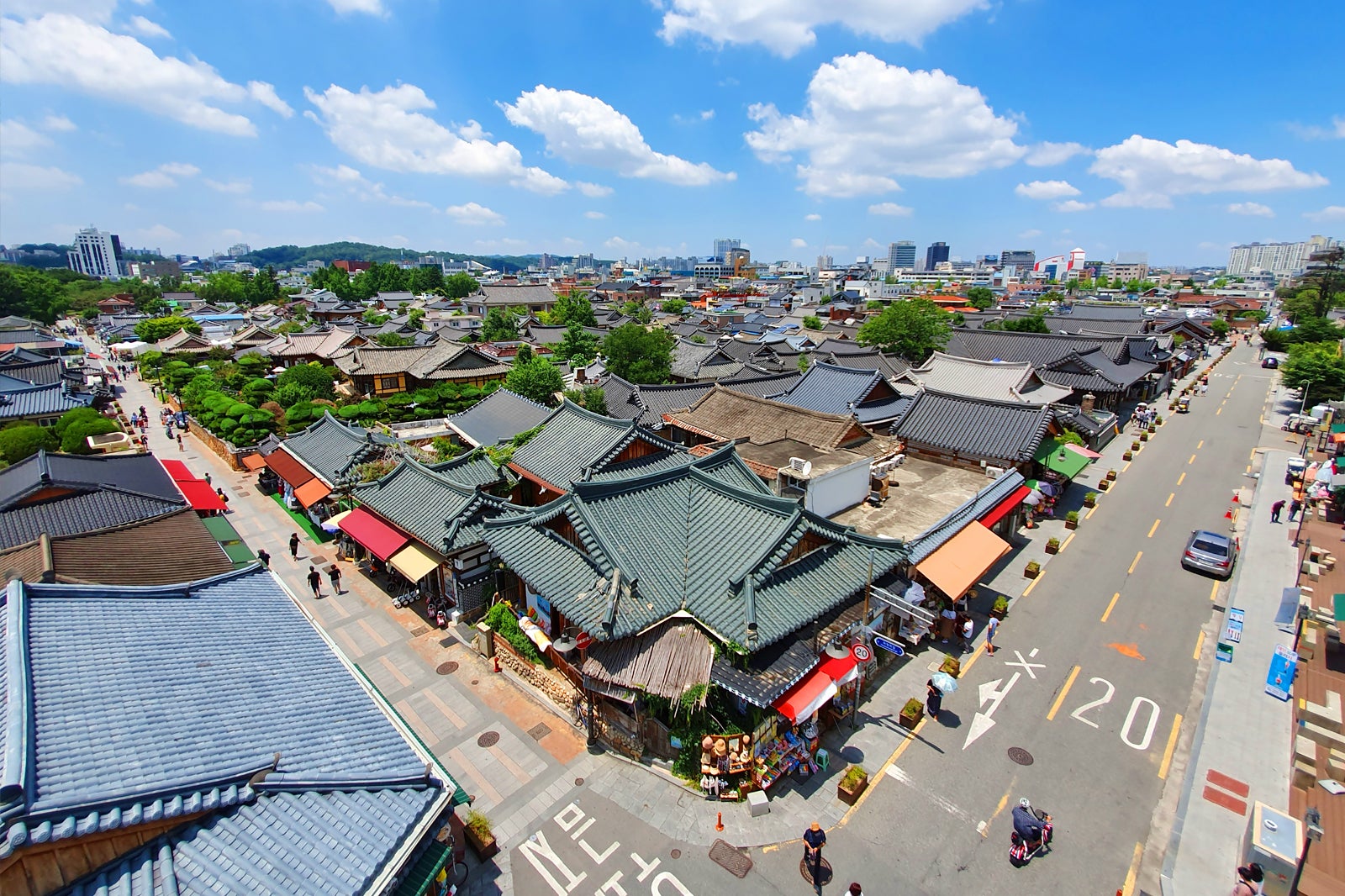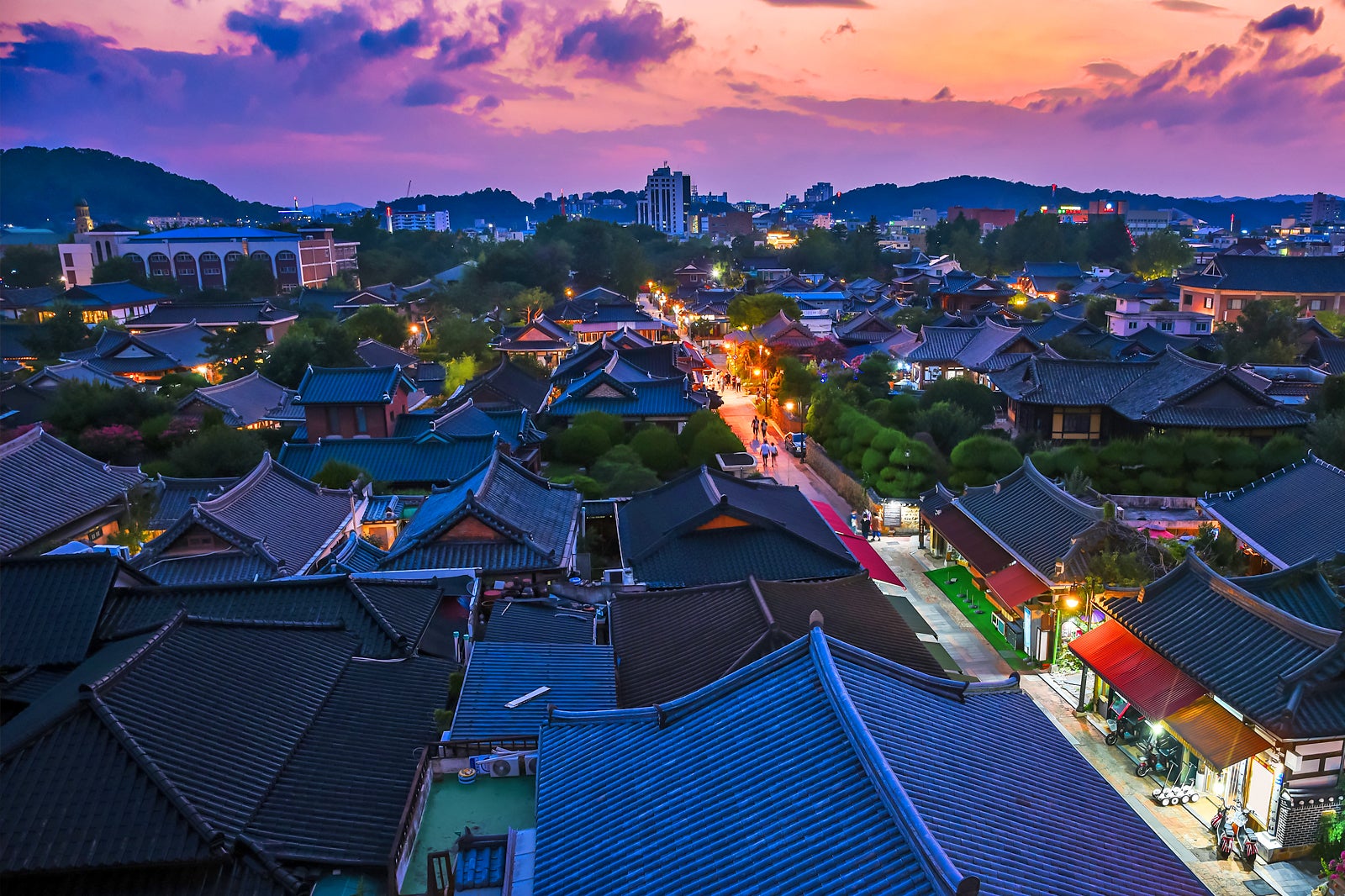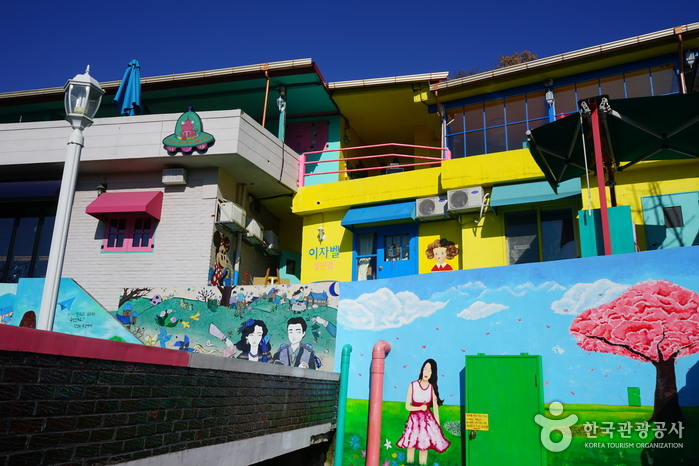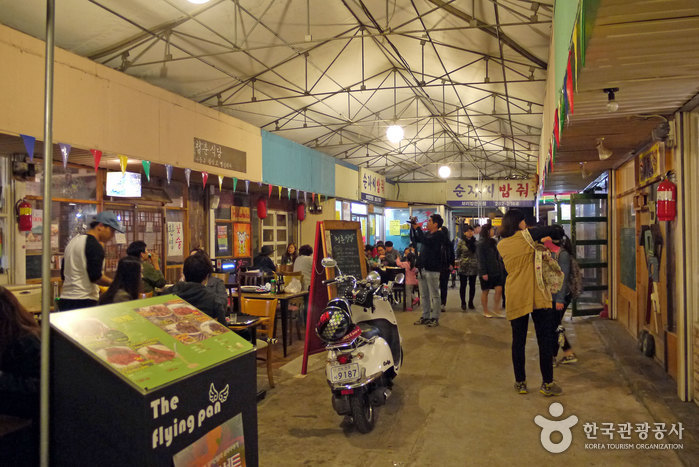Jeonju (Korean pronunciation: [tsʌn.dzu]) is the 16th largest city in South Korea and the capital of North Jeolla Province. It is a unique blend of urban and rural areas, largely due to its close proximity to Wanju County, which almost completely surrounds Jeonju. Many residents of Wanju County work in Jeonju. The name Jeonju literally means “Perfect Region” (from the hanja 全 (전; jeon) for perfect, 州 (주; ju) for region). It is an important tourist center renowned for its Korean food, historic buildings, sports activities, and innovative festivals.
In May 2012, Jeonju was designated as a Creative City for Gastronomy by UNESCO’s Creative Cities Network. This distinction acknowledges the city’s rich culinary heritage, which has been passed down for thousands of years. Jeonju is actively involved in both public and private food research, has a system in place to cultivate talented chefs, and hosts distinctive food festivals.

History
The Baekje kingdom was situated in southwestern Korea, including the area where Jeonju is currently located. Jeonju is believed to have originated as a market town within Baekje around 57 BCE.
In 660 CE, Jeonju, along with Baekje in general, was conquered by the kingdom of Silla and their Chinese Tang allies. It became part of the Silla kingdom and was designated as one of the nine chu, or provincial capitals, in 685. From 889 onwards, peasant revolts stemming from overtaxation became widespread throughout the kingdom, including Jeonju. It became the headquarters of one of the most powerful rebel leaders of that time, Gyeon Hwon. In 892 or 900, Gyeon Hwon renamed the city Wansan and established it as the capital of the Later Baekje kingdom. From Wansan, Gyeon Hwon waged campaigns against Silla, culminating in the destruction of Geumseong, the capital of the Silla kingdom, and the assassination of King Gyeongae in 927. With the decline of Silla, Wang Geon of the Goryeo kingdom invaded Later Baekje in 934, and Jeonju surrendered to him in 935.
Under Goryeo rule, Jeonju returned to being a provincial capital and enjoyed relative stability and economic growth. However, in 1182, the city was taken by peasant rebels with the aid of governmental troops stationed there who resented being forced to do heavy labor alongside slaves. The rebellion was suppressed after forty days.
In 1392, the Joseon dynasty overthrew Goryeo and established a new dynasty, taking possession of Jeonju. The Joseon considered Jeonju their ancestral home, as an ancestor of Yi Seonggye of Joseon may have fled Jeonju after the peasant revolt of 1182. During the Joseon period, Jeonju became the capital of a reorganized Jeolla province, one of the eight provinces of Joseon. In 1413, Jeonju, along with three other cities, was entrusted with the safekeeping of copies of the Annals of the Joseon Dynasty, which still exist today in the former Confucian academy in Jeonju.
In 1894, the town was occupied by the Donghak Peasant Revolution. Jeonju, like the rest of Korea, was subsequently occupied by the Japanese from 1910. The ancient walls of the old city were destroyed by the Japanese authorities, with the Pungnammum Gate being the only remnant remaining today. Jeonju’s population grew from 1925 to 1949, reaching 100,000 inhabitants. It was granted metropolitan status in 1935, and the city itself was founded in 1949. During the division of Korea, Jeonju was not on the immediate frontline of the war but suffered bombardment and the loss of many male residents who fought during the conflict by the time the armistice was signed in July 1953.
Jeonju received its modern boundaries and government system in 1963 and has since undergone rapid industrialization. However, compared to other parts of Korea, it did not experience the same level of industrial infrastructure, manufacturing, or heavy industries in the 20th century. Today, traditional tourism and sightseeing are major industries in the city.

Culture
The Jeonju International Film Festival (JIFF) is an Asian film festival that was established in 2000. Initially, it started as a non-competitive film festival with partial competition and aimed to showcase independent and experimental films, focusing on the alternative aspects of contemporary film art.
During the first edition of JIFF, debut films by Darren Aronofsky were introduced to South Korea, along with early works of Béla Tarr, which were showcased in Asia for the first time. The festival’s International Competition Section has awarded notable filmmakers such as Ying Liang, John Akomfrah, and Miike Takashi.
One unique aspect of JIFF is its involvement in film production. Directors who have been invited to the festival have also been later invited to participate in the Jeonju Digital Project (JDP), which consists of three digital shorts. JDP provides financial support to accomplished directors for their short films and premieres these works at the festival.
Celebrating its 15th edition, the JDP has expanded its scope to include feature-length films, with the participation of filmmakers such as GYÖRGY Pálfi from Hungary and PARK Jung-bum/SHIN Yeon-shick from the Republic of Korea.
Another notable feature of JIFF is its experimental section called “Expanded Cinema,” previously known as “Stranger than Cinema.” This section provides a platform for avant-garde and experimental works that push the boundaries of traditional filmmaking.
Overall, the Jeonju International Film Festival is renowned for its promotion of independent and experimental cinema, as well as its support for film production through initiatives like the Jeonju Digital Project.
Jeonju Hanok Village
Jeonju Hanok Village is a charming village located within the city of Jeonju, South Korea. It encompasses the neighborhoods of Pungnam-dong and Gyo-dong and is renowned for its collection of over 800 traditional Korean houses known as ‘Hanok.’ These traditional buildings stand in stark contrast to the modern cityscape that surrounds the village.
The village holds significant appeal for both Koreans and tourists due to its preservation of traditional architecture and cultural heritage. In 2010, it was designated as an International Slow City, acknowledging its relaxed pace of life and the harmonious blend of traditional culture and nature.
Over the years, the popularity of Jeonju Hanok Village has soared, resulting in a significant increase in visitor numbers. From 2007 to 2014, the number of visitors more than doubled, surging from 3.17 million to 7.89 million. Among major tourist cities in Korea, excluding Seoul, Jeonju ranks third in terms of visitor numbers, trailing only Jeju and Busan.

The city of Jeonju holds great historical significance in Korea. It served as the capital of the Hubaekje Kingdom, established by Gyeon Hwon in the 10th century. The city also held spiritual importance during the Joseon Dynasty because the Yi royal family originated from Jeonju. In this dynasty, Jeonju governed the Jeolla-do region, including Jeju Island, and served as a central administrative hub. This rich historical background is why Jeonju is often referred to as ‘the ground of more than 1000 years of history.’
The roots of settlement in the Jeonju area can be traced back over 10,000 years. Initially, people inhabited the foot of a mountain, and later, during the Silla kingdom, they began to move into the flatlands surrounding the mountain. As the city developed, a defensive wall was constructed, leading to the formation of many villages around it. These villages eventually evolved into the present-day Hanok village, which has become a popular tourist attraction in Jeonju.
During the Korean Empire period, the city wall of Jeonju was demolished, and the residential area within the wall began to expand into the Pungnam-dong and Gyo-dong districts, particularly influenced by the Yangban class. This expansion contributed to the growth and development of the city.
Overall, Jeonju’s historical significance, dating back thousands of years, combined with its unique Hanok village, has made it a compelling destination for tourists seeking to explore Korea’s rich cultural heritage.

Attractions
Omokdae

On the eastern side of Hanok Village in Jeonju, there is a significant historical site related to Lee Seonggae, the founder of the Joseon Dynasty. This location is where Lee Seonggae held an outdoor banquet to celebrate his triumphant return to Gaegyeong (the capital at the time) after a victorious campaign against Japanese coastal invaders at Hwangsan Mountain. The site is situated at a high elevation, offering visitors a splendid view of the surrounding scenery.
Due to its historical importance and picturesque setting, many tourists choose to begin their exploration of Jeonju at this location. It serves as a starting point for discovering the rich history and cultural heritage of the area, especially in relation to the founding of the Joseon Dynasty by Lee Seonggae.
In Korean: 오목대 ( Omokdae ), 이목대 ( Imokdae )
Address: 55 Girin-daero, Wansan-gu
Open year-round. Free admission.
Jeonju Hyanggyo
The Jeonju Hyanggyo served as a Confucian temple and educational institution for students in Jeonju during the Joseon Dynasty. Its origins date back to the Goryeo Dynasty period when it was initially constructed by the King of Gongmin in 1354. Originally, it was situated at the Gyeonggijeon Shrine site in Jeonju. However, due to two separate wars, it had to be relocated twice.
The main area within the shrine grounds is the Daeseongjeon, which served as the Confucian Shrine Hall. It is positioned in the front of the complex. In contrast, the primary teaching space, known as the Myeongyundang, or lecture hall, is located at the rear. This arrangement deviates from the typical layout of hyanggyos. The Jeonju Hyanggyo consists of a total of 99 rooms.
Recognized for its historical and cultural significance, the Jeonju Hyanggyo holds the distinction of being designated as a Korean Historical Treasure. It stands as a testament to the Confucian educational system that played a crucial role in shaping the intellectual and moral foundations of the Joseon Dynasty.
Gyeonggijeon

Gyeonggijeon is a significant hall in Jeonju where the portrait of Lee Seonggae, the founder of the Joseon Dynasty, is enshrined. It was originally constructed in 1410, during the 10th year of King Taejong’s reign. Gyeonggijeon holds the distinction of being designated as a Private Historical Landmark in Korea, while the portrait of Lee Seonggae itself is recognized as a National Treasure.
Situated in front of Jeonju Hanok Village, Gyeonggijeon attracts a large number of tourists who often visit it as their first stop. The original size of Gyeonggijeon was larger than its present form. However, during the period of Japanese Colonialism, the west side of Gyeonggijeon and its annex were demolished to make way for a Japanese elementary school. The remaining structure is a simple building consisting of outer and inner gates.
Despite its reduced size, Gyeonggijeon continues to hold immense historical and cultural significance as the place where the portrait of Lee Seonggae is revered. It stands as a testament to Korea’s rich heritage and attracts visitors eager to learn about the country’s past.
In Korea: 경기 전 ( Gyeonggijeon )
Address: 44 Taejo-ro, Wansan-gu Entrance fee: 3,000
wons (approx. 2.20 euros)
Pungnammun Gate
Pungnam Gate holds historical significance as the southern gate of the city wall that once surrounded Jeonju during the Joseon Dynasty. It is the only remaining gate following the destruction of the wall. Recognized for its cultural value, Pungnam Gate was designated as National Treasure #308 on January 21, 1963.
During the Joseon Dynasty, Jeonju served as the capital for provincial governors, necessitating the construction of fortifications to enclose the city. These fortifications included gates in all four directions. However, in the 30th year of King Seonjo’s reign (1597), all the gates, except Pungnam Gate, were demolished.
After extensive repair work that commenced in 1978, Pungnam Gate was successfully restored. Notably, the gate’s architectural design, particularly the column arrangement on the second story, showcases a unique and rare Korean building style.
Pungnam Gate stands as a testament to Jeonju’s historical significance and serves as a cherished cultural heritage site, attracting visitors who wish to appreciate its architectural beauty and delve into the city’s rich past.

Its architecture is quite unique, as its columns span the first and second floors of a wooden superstructure. You can’t visit the inside, but you can freely walk around it. In the evening, it is very nicely lit.”
In Korean: 전주 풍남문 ( Jeonju Pungnammun )
Address: 1 Pungnammun 3-gil, Wansan-gu
Open all year round.
Jeondong Catholic Cathedral
The Jeondong Cathedral[1] (Korean: 전동성당), also known as the Old Cathedral of Jeondong and now as the Jeondong Church of Francis Xavier, holds significant importance as a Catholic church in Jeonju, South Korea.
The cathedral building, designed in the Roman-Byzantine style, was constructed between 1908 and 1914 by Victor Louis Poisnel (1855-1925). It falls within the jurisdiction and supervision of François-Xavier Baudounet (1859-1915), a French priest born in Mostuéjouls, Aveyron, the same region where numerous Christians were martyred. Situated in the city center, close to the traditional Jeonju Hanok Village, this church is considered a historic landmark.
Presently functioning as a parish church, the cathedral is under the authority of the Diocese of Jeonju (Dioecesis Ieoniuensis or 전주 교구).
The Sacred Heart Kindergarten is an institution affiliated with the cathedral, while the Jeonju Sacred Heart Girls’ Middle School (attended by Wheein and Hwasa) and Jeonju Sacred Heart Girls’ High School are located nearby.
History
The Jeondong Catholic Church in Jeonju, completed in 1914, was designed by Priest Poinel, who was also the architect behind the famous Myeongdong Cathedral in Seoul. It holds the distinction of being the largest and oldest Western-style structure in the Jeollanam-do and Jeollabuk-do provinces of South Korea. The church was constructed on the site where Yun Ji-chung (1759-1791), the first Korean Catholic martyr, died.
The Jeondong Cathedral is one of South Korea’s three prominent Catholic churches, alongside the Myeongdong Cathedral in Seoul and the Gyesan Catholic Church in Daegu. Its architectural style is a blend of Romanesque and Byzantine influences, resulting in a visually striking and captivating structure. Regarded as one of the most beautiful buildings in Korea, it stands as a testament to the rich cultural heritage of the region.

In Korean: 전동성당 ( Jeondong Seongdang )
Address: 51 Taejo-ro, Wansan-gu
Open year-round. Free admission.
Jeonju Hyanggyo
The Jeonju Hyanggyo is a historical school that was originally established at the Gyeonggijeon Shrine site in Jeonju, Korea, during the early 15th century, within the Joseon Dynasty (1392-1910). The Gyeonggijeon Shrine was constructed in 1410, indicating that the construction of the Jeonju Hyanggyo followed sometime later.
During the Second Japanese Invasion in 1592, both the Gyeonggijeon Shrine and the Jeonju Hyanggyo were completely destroyed. In 1603, the hyanggyo was relocated and reconstructed at its present location in Jeonju.
Unlike the more typical Jeonhakhumyo style observed at the Goheung Hyanggyo, the Jeonju Hyanggyo features a less conventional design of being situated on level ground. The memorial enshrinement area is centered around the Daeseongjeon (Confucian shrine hall) at the front, while the educational area revolves around the Myeongyundang (lecture hall) located at the rear. This configuration is uncommon for a hyanggyo. In total, the Jeonju Hyanggyo comprises 99 rooms.
Recognized for its historical significance, the Jeonju Hyanggyo holds the designation of a historical treasure.

In Korean: 전주향교 ( Jeonju hyanggyo )
Address: 139 Hyanggyo-gil, Wansan-gu
Open 9am-6pm in summer, 10am-5pm in winter. Free admission.
Jaman Mural Village
Jaman Mural Village is situated on the ridge between Omokdae and Imokdae, nestled along the base of Seungamsan Mountain’s Jungbawi Rock. The village offers a picturesque view of Jeonju Hanok Village from its broad street. While the ascent to Jaman Village may be moderately steep, visitors will be rewarded with a delightful experience as they encounter vibrant murals adorning the buildings and walls along the pathway.

In Korean: 자만벽화마을 ( Jaman byeokhwa maeul )
Address: 1-10, Jamandong 1-gil, Wansan-gu
Open year-round. Free admission.
Foodie Jeonju
Jeonju is renowned as the “city of taste” and has earned this reputation due to three key factors: rice cultivation in the Honam plain, the gathering of wild vegetables from the surrounding mountains, and fishing in the waters of the Yellow Sea.
Recognizing the city’s dedication to preserving its long-standing culinary traditions, UNESCO has included Jeonju in its network of “creative cities”. Jeonju has demonstrated significant efforts in maintaining its culinary heritage through various means such as engaging in exchanges with other Cities of Gastronomy, active participation in international forums, and providing support to local chefs. In essence, Jeonju is a city where one can indulge in exquisite dining experiences.
The bibimbap , this essential dish
Bibimbap is a popular Korean rice dish known for its delicious combination of flavors and textures. The name “bibimbap” translates to “mixed rice” in English, highlighting the preparation method of combining various ingredients with rice.
Traditionally, bibimbap consists of a bowl of steamed white rice topped with an assortment of namul (seasoned and sautéed vegetables) or kimchi (fermented vegetables). It is typically garnished with gochujang (a spicy chili pepper paste), soy sauce, or doenjang (fermented soybean paste) to add depth of flavor. Additional toppings often include a raw or fried egg and sliced meat, commonly beef.
To enjoy bibimbap, the hot dish is thoroughly mixed together just before eating, ensuring that the flavors blend harmoniously. This mixing process evenly distributes the ingredients throughout the rice, creating a satisfying and flavorful meal.

Gyodong Dawon Tea House
Jeonju boasts several wonderful teahouses, but the one I hold dear is particularly special to me. It is housed in a traditional wooden structure, featuring a spacious entrance that seamlessly connects with the surrounding garden. The atmosphere inside is tranquil and serene, creating an ideal environment for introspection and the appreciation of fine tea.
Within this teahouse, you can expect a focus on high-quality teas. The selection is carefully curated, ensuring that each tea offers a delightful and memorable experience. Whether you seek a moment of meditation or simply wish to indulge in the art of tea drinking, this teahouse provides an exceptional setting to unwind and savor the flavors and aromas of exquisite teas.
If there were no more places, try your luck at Daho, at 12-3 Taejo-ro.
In Korean: 교동다원 ( Gyodong dawon )
Address: 65-5 Eunhaeng-ro, Gyo-dong, Wansan-gu
Open every day except Tuesday, from 11 am to 10:30 pm.
Nambu Market
Jeonju Nambu Traditional Market has a rich history, tracing back to its establishment in 1905 as a public market on the grounds of the Joseon-era Nammunbakk Market, which was situated just outside the Southern gate of the city. Presently, the market comprises around 800 stores with approximately 1,200 workers offering a diverse range of goods, including vegetables, fruits, food items, dried fish, furniture, silk products, and general merchandise.
To breathe new life into the market, the Youth Market was created within the previously vacant shops on the second floor of 6-dong. This addition has attracted a wave of young shopkeepers and entrepreneurs, infusing the marketplace with a vibrant and dynamic atmosphere reminiscent of popular areas like Hongdae or Samcheong-dong.
One of the highlights of the market is the night market held on Fridays and Saturdays. This event entices numerous visitors with a wide array of delectable treats. From traditional dishes such as nokdujeon (mung bean pancake) to fusion creations like bibimbap wrapped in rice paper resembling a spring roll, there is an abundance of culinary delights to indulge in. The night market provides a delightful opportunity to explore unique flavors and enjoy a vibrant food scene in Jeonju.

In Korean: 전주 남부시장 ( Jeonju Nambu sijang )
Address: 2-242 Jeonong 3-ga, Wansan-gu,
Open year-round. Free admission.
Jeonju the cultural
Jeonju International Sori Festival
The Jeonju International Sori Festival, established in 2001, holds significant prominence as South Korea’s primary event dedicated to traditional music, and since 2011, world music as well. The festival has gained international recognition for its cultural significance and artistic excellence.
Notably, in 2012, 2013, and 2014, Songlines, a renowned world music magazine, included the Jeonju Sori Festival in its esteemed list of the World’s Best 25 International Festivals. It was the sole Asian festival to be featured on this prestigious list, underscoring its exceptional standing in the global festival landscape.
This recognition highlights the festival’s commitment to showcasing diverse musical traditions, fostering cross-cultural exchanges, and celebrating the richness of traditional and world music. The Jeonju International Sori Festival has undoubtedly contributed to promoting cultural heritage and strengthening international appreciation for traditional and world music genres.

In Korean: 전주 세계 소리 축제 ( Jeonju segye sori chukje )
Address: 1F Conference Hall, Sori Arts Center of Jeollabuk-do, Sori-31, Deockjin-gu, Jeonju-si
Website Internet: www.sorifestival.com
